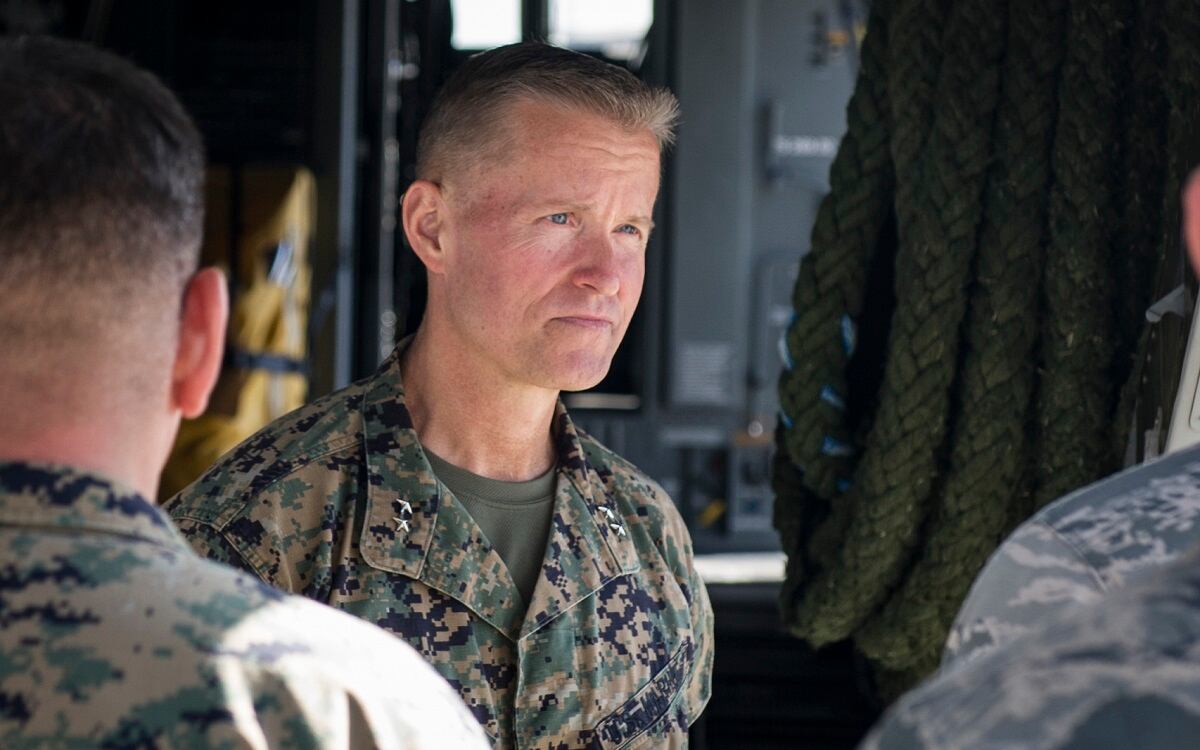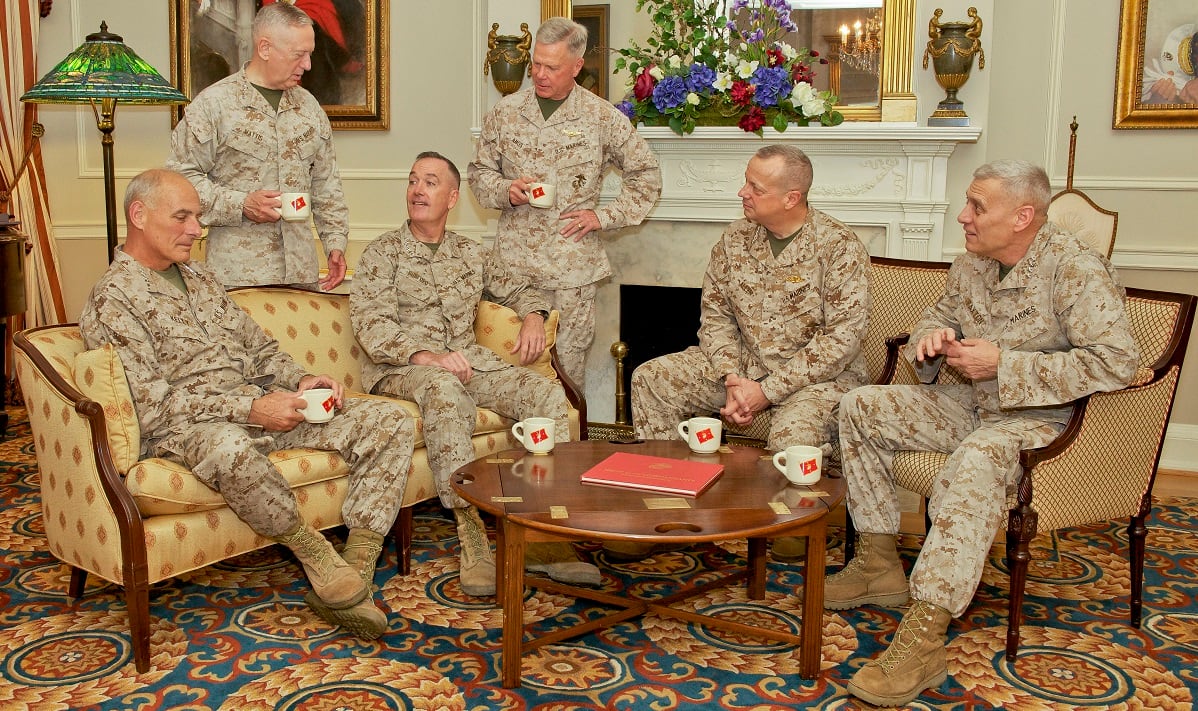For much of the Marine Corps’ history its top leaders have fought for a place at the table, having to elbow the larger services with much bigger budgets just to stay in the game.
Lionhearted Marines had died in droves fighting during both World Wars, Korea and Vietnam. But in many eras, the smallest branch’s official role has been limited to the Navy’s maritime expeditionary arm, which has had to make do with less money, manpower and priorities as its sister services, which have long steered the military aspects of national security policy.
But, now, for the first time, there are more Marines in top military and civilian positions at the highest levels of government.
Right now a retired or uniformed Marine holds the seat of secretary of defense, White House chief of staff, chairman of the Joint Chiefs of Staff, head of Africa Command and incoming head of United States Central Command.
RELATED

The combined Army, Army Reserve and Army National Guard has more than 1 million uniformed members. It is twice the size of the Navy and has nearly two-thirds more people than the Air Force. The Marine Corps and its reserve component have about 220,000.
There are five soldiers for every one Marine.
So how did we get here?
A close reading of the focus of key officers, performance in the past generation of warfare and the steps Marines took preceding 9/11 could provide some answers as to why Marines now are holding an outsized number of positions.
An ‘uneasy’ situation
Today, the Marines are on top.
Secretary of Defense James Mattis and White House Chief of Staff John Kelly hold top positions of influence in both White House policy and defense department matters.
Current Marine generals such as Chairman of the Joint Chiefs of Staff Gen. Joseph Dunford, AFRICOM commander Gen. Thomas Waldhauser and incoming CENTCOM commander Lt. Gen. Kenneth McKenzie Jr. lead top commands involved in active combat.
Mattis recently nominated Marine Maj. Gen. George W. Smith Jr. for his third star and an assignment as his senior military assistant. Smith serves as special assistant to the director of the joint staff.
Even the Brookings Institution, a leading D.C. think tank on foreign policy for more than a century, is being led by retired Marine Gen. John Allen. He’s the first Marine to serve as its president.
There have been 218 active-duty Army four-star generals in its history, nearly 200 since World War II.
The Marines didn’t even have a four-star general until the end of World War II. There have been about 50 active duty four-stars since.
Ten of 14 commanders of CENTCOM have been Army generals since its inception in 1983. Before 9/11, Marines had commanded it twice. Now, with McKenzie’s nomination, they are now entering their fourth turn.
Before 9/11 no Marine had ever commanded European Command. Similarly, only once before the terrorist attack had a Marine commanded Southern Command. The second was then-Gen. John Kelly.
The Marine Corps didn’t hold a seat on the Joint Chiefs of Staff until 1978, nearly 30 years after it was created. The Corps didn’t chair the staff until 2005.
Retired Army Gen. Barry McCaffrey, former commander of SOUTHCOM, sees the outsized role of Marines in leadership roles as an ‘uneasy’ situation, especially as the defense strategy under President Donald Trump shifts to great power competition.
McCaffrey credited top Marine leaders with having unique talent and called Mattis, Dunford and Kelly some of the “finest public servants this country has ever produced.”
He said the Marines’ development and management of senior officers put them in joint and nonstandard career track positions has helped them better compete for by-name nominations.
By contrast, he said the Army has been wary of assigning officers to such paths.
“To be honest it makes me uneasy to see the outcome,” McCaffrey wrote in an email to Marine Corps Times.
He pointed to the Army as being the centerpiece of national security and an outsized Marine-centric thinking could hurt larger efforts.
“For a decade we have been inadequately represented,” the four-star said of the Army.
The Corps’ current position in high places may not continue, irrespective of national security priorities.
Media outlets such as The New York Times have recently reported that both Mattis and Kelly are losing favor with President Donald Trump for several reasons including past disagreements and for alleged insults revealed in a book titled, “Fear: Trump in the White House,” by Bob Woodward, veteran journalist for the Washington Post.
But Mattis recently told reporters that he isn’t going anywhere yet.
And the Marine power-hold may continue.

A Cold War role
Despite successes in World War I and II, Marines found themselves in the late 1940s fighting for their very existence.
The newly created Air Force, alongside the Army and Navy, was preparing for the growing Cold War with the Soviet Union and their roles in it.
That fight imagined massed armies slugging it out on the plains of Europe, with a buildup of hundreds of thousands of U.S. soldiers on the continent. Or it envisioned trading barrages of nuclear weapons, first from air-centric bombing runs suited to the Air Force and then from the added nuclear submarine fleet and later from Intercontinental Ballistic Missiles, also controlled by the Air Force.
The Marine Corps struggled as a bit player in that conversation. The Corps was seen more as a shock troop organization that could perhaps land in amphibious environments to achieve a small-scale objective as the Army gathered their strength for the real fight.
But, in practice, Marines saw much of the actual engagements.
Marines basically operated as a small land army in Korea and Vietnam and many of the smaller engagements throughout Latin America and later Africa and the Middle East into the early post-Cold War period.
“Only the Korean War led to building back up the Marine Corps,” said Richard Shultz Jr., a professor of national security studies at the Fletcher School, Tufts University. “All of the Cold War, with the exception of Vietnam, if there was going to be a land war fought, the Marines were not going to be the main force.”
As the Cold War wound down and America saw quick victory in the Persian Gulf War with a massive buildup that included scores of partner nations, top Marine Corps leaders were looking in a different direction, Shultz said.
Post-9/11 success
Shultz points to retired Gen. Charles Krulak, commandant of the Marine Corps from 1995-1999, as a driving force in setting up the service for post-9/11 success.
In speech after speech, Krulak admonished leaders at the time to recognize that future wars would be fought on a much lower level and rapidly transition from direct combat to humanitarian aid.
He created the Marine Corps Warfighting Laboratory, which helped form the asymmetrical, concept known as the “three-block war” where the key leadership was not a general, but a “strategic corporal.”
That, Shultz says, helped the Corps reorient itself first to the tasks of the time, peacekeeping missions in Somalia, Bosnia, Liberia and East Timor.
“Now we call these irregular wars,” Shultz said. “He started to get the Marine Corps ready for that.”
The flexibility built into the lowest ranks of Marine Corps units, coupled with what Schultz characterized as a premium put on education among the Marine officers, helped position the force for successes both on the battlefield and in D.C.
The education portion he credits to retired Gen. Al Gray, commandant from 1987-1991, who established the commandant’s reading list and helped support Marines at all ranks focus on intellectual achievement.
Then came 9/11, with Marines in the fight in Afghanistan and Iraq at the very beginning. This was in part because Marine Expeditionary Units are afloat and able to bring firepower to small-unit operations and invasions.
“So, the Marine Corps began to get a lot more experience in this kind of war,” Shultz said. “And it had generals who were ready for it.”
And Marines placement in high positions began shortly afterward.
In 2005, Gen. Peter Pace was appointed the first-ever Marine chairman of the Joint Chiefs.
That year, then-Secretary of Defense Donald Rumsfeld signed off on the creation of the Marine Corps Special Operations Command, bringing Marines to the joint special operations forces community after a quarter-century delay.
That was followed by Mattis being appointed first as head of U.S. Joint Forces Command and then as commander of CENTCOM in 2010.
In 2011, Allen took over as commander of International Security Assistance Force in Afghanistan.
Three years later he served as the first Special Presidential Envoy for the Global Coalition to Counter the Islamic State of Iraq and the Levant.
Some of the 1990s reorientation helped early in the Iraq War, Shultz said. He wrote a study titled, “The Marines Take Anbar: The Four-Year Fight against Al Qaeda.”
The professor points out that while then Gen. David Petraeus was still drafting the Army field manual that would define counterinsurgency, or COIN, operations, Marines were already
using such techniques as part of their campaign plan.
“Humanitarian assistance is part of COIN,” Shultz said. “So, when Marines got to COIN in Anbar they adapted and understood not only the ‘clear and hold’ but also the ‘build’ portion of it.”
Seeds planted by leaders going back to Gray, new organization such as the warfighting lab, and its concepts applied to help the service pivot to immediate military missions put it on solid footing when those exact types of missions dominated the post-9/11 landscape.
Successes by commanders and their units in those fights and positioning in joint roles likely helped leaders such as Mattis, Kelly, Allen, Dunford and others claim their seats at the table.
Todd South has written about crime, courts, government and the military for multiple publications since 2004 and was named a 2014 Pulitzer finalist for a co-written project on witness intimidation. Todd is a Marine veteran of the Iraq War.




